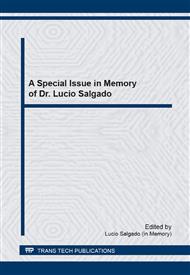p.111
p.116
p.122
p.128
p.137
p.143
p.149
p.155
p.161
Optimization of Aluminum Anodizing and Coloring Process Employing Organic Pigment
Abstract:
The process of aluminum anodizing forms an oxide layer constituted of nanotubes where it is possible to insert compounds, amongst these are the pigments and dyes. This study has as its main aim to study the behavior of aluminum alloy 6000, anodized and dyed with monolite red in Na2SO4 0.5 mol L-1 and pH = 4. The techniques employed were: anodic potentiostatic polarization, open circuit potential, chemometry, polarization resistance and optical micrograph. The factorial planning was proposed using four variables (anodizing time, current density, electrolyte concentration, and dye), the response to the planning was the charge transfer resistance. Polarization curves revealed that the anodized and dyed aluminum samples are much more resistant than the non-anodized aluminum. Optical microscopy analyses demonstrated that the dissolution of dye occurs in the solution, but not enough to break the film. As the main result, efficient coloring of aluminum parts was verified with reduction in costs in relation to the energy employed in the process, associated to reduction in time spent for the anodizing process, which makes it suitable to increase industrial production of dyed aluminum parts.
Info:
Periodical:
Pages:
137-142
Citation:
Online since:
September 2014
Keywords:
Price:
Сopyright:
© 2015 Trans Tech Publications Ltd. All Rights Reserved
Share:
Citation:


